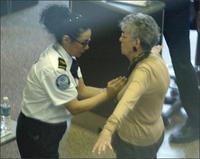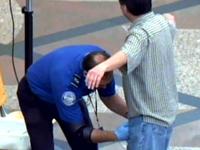-
Versatile terahertz technology could help aircraft to land
Terahertz scanners detect a type of high-frequency electromagnetic radiation emitted by anything with temperatures higher than around 10 kelvin; it can penetrate dry, non-metallic materials such as clothing or sand, but is absorbed by water and metal; terahertz thus makes for very accurate airport scanners — but the technology can also be used to help aircraft land in poor visibility or power high-bandwidth communication systems
-
-
Napolitano says scanners may be used for trains, subways, and boats
DHS secretary Janet Napolitano says that full-body scanners may be deployed in train stations, on subway platforms, and in marinas; experts point out that terrorists would not necessarily need to board a train to do damage: train graffiti is one indication how easy it to access parked trains — and trains roll on miles and miles of exposed track in open landscapes
-
-
Full-body scanner privacy concerns could be easily solved
A U.S. government scientists involved in developing the full-body scanner says privacy concerns can be easily addressed by adding a simple algorithm to the scanners’ computer code; the algorithm distorts the body image into “grotesque” shapes without degrading the scanner’s detection capabilities
-
-
Police radar can identify suicide bombers
The radar guns police use to spot speeding motorists fire microwave pulses at a car and measures the Doppler shift of the reflected signal to calculate its velocity; researchers found that the strength and polarization of the reflected signal — the “radar cross section” — can also measure the reflected signal created by the most common arrangements of looped wiring typically used by suicide bombers
-
-
Tungsten-lined undies protect naughty bits from radiation
A Colorado company offers an attractive line of tungsten-lined undies, aimed, the company says, to protect “the traveling public, airline, medical, and security professionals from radiation generated by security and medical imaging equipment”; business is booming
-
-
Full-body-scan "opt-outs" at U.S airports at normal rate
The organizers of the airport screening “National Opt-Out Day” hoped to exploit the American public’s anger at, and dissatisfaction with, the current state of affairs — anger that found expression earlier this month in the midterm elections — for a spectacular demonstration which would paralyze domestic air-travel during the busy Thanksgiving travel period: they called on travelers to opt-out of full-body scanning, thus forcing TSA screeners to pat them down, bringing air travel to a halt; the organizers failed to reckon with two set of numbers: fewer than 3 percent of travelers receive pat-downs, and the vast majority of Americans — as much as 80 percent — approve of full-body scanners being used at U.S. airports; the result: the stunt has failed, and the number of travelers opting out of full-body scans is not higher than normal
-
-
Spotting illicit nuclear activity from a distance
French scientists unveil a plan to place antineutrino detectors off the coast of rogue nations suspected of operating clandestine nuclear reactors; their idea is to turn a supertanker into an antineutrino detector by kitting it out with the necessary photon detectors and filling it with 10^34 protons in the form of 138,000 tons of linearalkylbenzene (C13 H30); the plan is to sink the tanker in up to four kilometers of water off the coast of a rogue state, and the supertanker would then watch for the telltale signs of undeclared antineutrino activity
-
-
Lawmakers demand better TSA pat-down training

Lawmakers write the president, TSA to demand a better system of security checks at airports; demand ; “Surely it is possible to secure an airplane without sacrificing individual liberties or privacy. We can utilize bomb-sniffing dogs, AIT machines as a method of secondary screening, and behavioral profiling to accomplish the shared goal of safe and secure air travel,” Rep. Jason Chaffetz (R-Utah) wrote Obama; “These new searches are a novel procedure both for the traveling public and your front line TSA officers, and I am not convinced the Transportation Security officers have received adequate training in what is clearly an invasive procedure,” Senator Olympia Snowe (R-Maine) wrote the TSA administrator
-
-
Nuclear DUI: DOE IG finds cause for concern
There are about 600 OST (Office of Secure Transportation) agents — that is, drivers who have permits to haul nuclear weapons, weapons components, and special nuclear material (SNM) around the country; the Department of Energy inspector general investigated reports that some of these drivers are drunk on the job; a new report found 16 incident, of which 2 were of “particular concern”
-
-
TSA to make airports screenings "minimally invasive"

The head of the Transportation Security Administration (TSA), facing protests from travelers and pressure from the White House, appeared to give ground Sunday on his position that there would be no change in policies regarding invasive passenger screening procedures; John Pistole said in a statement that the agency would work to make screening methods “as minimally invasive as possible,” although he gave no indication that screening changes were imminent; still, he pointed to the alleged attempt by a Nigerian with explosives in his underwear to try to bring down an Amsterdam-to-Detroit flight last Christmas. “We all wish we lived in a world where security procedures at airports weren’t necessary,” Pistole said, “but that just isn’t the case”
-
-
U.S., Kazakhstan complete secret transfer of Soviet-era nuclear materials
In the largest such operation ever mounted, U.S. and Kazakh officials transferred 11 tons of highly enriched uranium and 3 tons of plutonium some 1,890 miles by rail and road across the Central Asian country; the nuclear material, which could have been used to make more than 770 bombs, was moved from a facility feared vulnerable to terrorist attack to a new high-security facility
-
-
Q&A: Full-body scanners
Questions are being raised about the privacy and health aspects of wide use of full-body scanners; here is one example: millimeter wave scanners, in theory, ought to be safer than X-rays because millimeter photons do not have enough energy to break chemical bonds; last year, however, researchers at Los Alamos National Laboratory found that while these photons cannot break DNA, they can shake it: this shaking may be so strong that it unzips the two strands in DNA, interfering with the genetic machinery that keeps cells working and healthy
-
-
TSA: Religion offers no exemption from airport screening

An airline passenger was thrown out of the San Diego airport for rejecting a full-body scan and pat-down groin check and instead insisting on passing through a metal detector; the Transportation Security Administration (TSA) says the agency will not allow airline passengers to get out of body imaging screening or pat-downs based on their religious beliefs; TSA chief John Pistole said that passengers who refuse to go through a full-body scanner machine and reject a pat-down will not be allowed to board, even if they turned down the in-depth screening for religious reasons; “That person is not going to get on an airplane,” Pistole said yesterday in a congressional committee testimony
-
-
Communications gap allowed packet bomb to go unchecked
German customs officials wanted to search last week’s package containing a bomb from Yemen, but it had left the country by the time the paperwork arrived; a communications breakdown enabled the explosive to pass through Germany without security checks; the security gap at the Cologne-Bonn Airport meant that the explosive-laden printer from Yemen avoided customs
-
-
Full-body scanners at U.S. airports may be dangerous: scientists
U.S. scientists warned that the full-body, graphic-image X-ray scanners now being used to screen passengers and airline crews at airports around the country may be unsafe; scientists say that most of the energy from the scanners is delivered to the skin and underlying tissue; “While the dose would be safe if it were distributed throughout the volume of the entire body, the dose to the skin may be dangerously high,” they say
-
- All
- Regional
- Water
- Biometrics
- Borders/Immig
- Business
- Cybersecurity
- Detection
- Disasters
- Government
- Infrastructure
- International
- Public health
- Public Safety
- Communication interoperabillity
- Emergency services
- Emergency medical services
- Fire
- First response
- IEDs
- Law Enforcement
- Law Enforcement Technology
- Military technology
- Nonlethal weapons
- Nuclear weapons
- Personal protection equipment
- Police
- Notification /alert systems
- Situational awareness
- Weapons systems
- Sci-Tech
- Sector Reports
- Surveillance
- Transportation
Advertising & Marketing: advertise@newswirepubs.com
Editorial: editor@newswirepubs.com
General: info@newswirepubs.com
2010-2011 © News Wire Publications, LLC News Wire Publications, LLC
220 Old Country Road | Suite 200 | Mineola | New York | 11501
Permissions and Policies
Editorial: editor@newswirepubs.com
General: info@newswirepubs.com
2010-2011 © News Wire Publications, LLC News Wire Publications, LLC
220 Old Country Road | Suite 200 | Mineola | New York | 11501
Permissions and Policies
